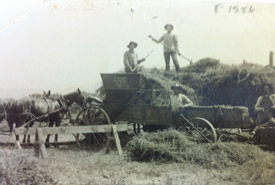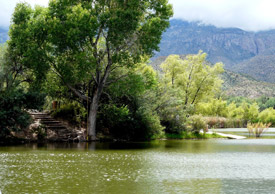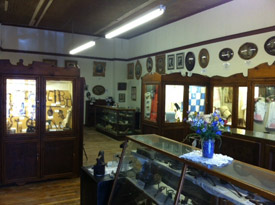|
|
Town Snapshot: Pima
Pioneer of the Gila Valley
Pima, Arizona, might never have been established if the northern boundary of the Fort Apache Reservation had been better defined in the mid-1870s.
Having built homes and planted fields a few miles south of Cooley Ranch (now Show Low), a dozen Mormon families learned they had settled on Apache
land and would have to find another place for their community. In 1878, an advance party staked out a new town site on the south bank of the Gila
River. They returned with their families in April 1879, and called their settlement Smithville after Jesse N. Smith, a prominent leader in Snowflake.
However, the territorial government refused this name and designated the post office as Pima. Eventually the new name stuck.
 Exploiting the remnants of Hohokam canals, pioneer farmers cultivated alfalfa, grains, and melons, with cotton eventually becoming the dominant crop.
Ranching was successful in the foothills of Mount Graham to the south, and on the lower slopes of the Gila Mountains to the north. Hauling freight
from the railroad near Willcox to the mines in Miami and Globe provided good supplemental incomes for early residents. Immigrants from Utah, Arkansas,
and Mexico made Pima the population center of Graham County until neighboring towns surpassed it in the 1930s.
Exploiting the remnants of Hohokam canals, pioneer farmers cultivated alfalfa, grains, and melons, with cotton eventually becoming the dominant crop.
Ranching was successful in the foothills of Mount Graham to the south, and on the lower slopes of the Gila Mountains to the north. Hauling freight
from the railroad near Willcox to the mines in Miami and Globe provided good supplemental incomes for early residents. Immigrants from Utah, Arkansas,
and Mexico made Pima the population center of Graham County until neighboring towns surpassed it in the 1930s.
 Even today a strong connection exists between Pima and Mount Graham. Many pioneers labored in logging operations on the mountain, and established cabins
and garden spots at Columbine for their families to escape the valley's summer heat. Today's Pima residents enjoy fishing, swimming and birding at the
Cluff Ranch Wildlife Area at the foot of the mountain, and camping or hiking in the cool spruce/fir forest around the mountain's 10,720-ft. summit.
Good hunting for small game, javelina, and deer is found within a 30-minute drive of town. In recent years, Pima has hosted one of the largest Scouting
activities in the U.S., the annual Varsity Scout Triathlon, with 1,122 competitors in 2012.
Even today a strong connection exists between Pima and Mount Graham. Many pioneers labored in logging operations on the mountain, and established cabins
and garden spots at Columbine for their families to escape the valley's summer heat. Today's Pima residents enjoy fishing, swimming and birding at the
Cluff Ranch Wildlife Area at the foot of the mountain, and camping or hiking in the cool spruce/fir forest around the mountain's 10,720-ft. summit.
Good hunting for small game, javelina, and deer is found within a 30-minute drive of town. In recent years, Pima has hosted one of the largest Scouting
activities in the U.S., the annual Varsity Scout Triathlon, with 1,122 competitors in 2012.
 Agriculture is still important, but today's Pima residents are more likely to be employed at one of the region's copper mines or correctional facilities.
Modern highways make for relatively short trips to Phoenix (2 1/2 hours) and Tucson (2 hours). Educational opportunities include the Pima Unified School
District (K-12) and Eastern Arizona College, five miles away in Thatcher. A sound utilities infrastructure is ready to provide power and naturally soft
water for any foreseeable growth over the next century. At the Eastern Arizona Historical Society's Museum (on the corner of Main and Center Streets)
visitors often inquire about still-heated controversies from the outlaw days-the never-really-solved robbery of an Army payroll in 1889, or the killings
at the Powers Mine in 1917.
Agriculture is still important, but today's Pima residents are more likely to be employed at one of the region's copper mines or correctional facilities.
Modern highways make for relatively short trips to Phoenix (2 1/2 hours) and Tucson (2 hours). Educational opportunities include the Pima Unified School
District (K-12) and Eastern Arizona College, five miles away in Thatcher. A sound utilities infrastructure is ready to provide power and naturally soft
water for any foreseeable growth over the next century. At the Eastern Arizona Historical Society's Museum (on the corner of Main and Center Streets)
visitors often inquire about still-heated controversies from the outlaw days-the never-really-solved robbery of an Army payroll in 1889, or the killings
at the Powers Mine in 1917.
One thing is certain: a stroll along any of Pima's wide, tree-lined streets in the quiet cool of the evening shows that the pioneers' dreams and labors
bore fruit - Pima is as likely a place as anywhere to settle, raise a family, and cultivate one's particular piece of paradise.
Visit www.pimatown.az.gov for more information.
|
|
League of Arizona Cities and Towns
1820 W. Washington St.
Phoenix, AZ 85007
Phone: 602-258-5786
Fax: 602-253-3874
http://www.azleague.org
|
|
|

